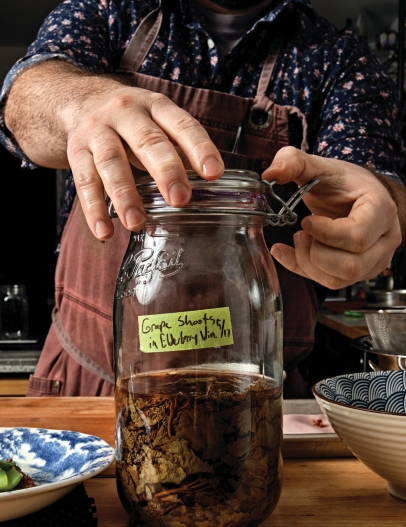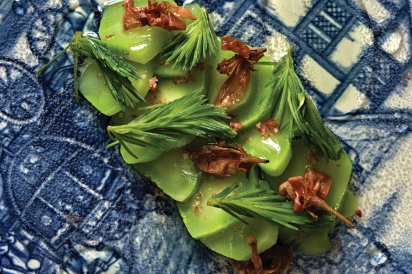Something Old, Something New: Preserving spring produce
Canned, pickled and fermented foods are an age-old tradition, and they can put a fresh spin on dishes by building flavors and adding an element of surprise.
EVER SINCE ANCIENT TIMES, when humans discovered they could harness the sun and wind to make their food supplies last longer by drying, food preservation has been an important part of the way we eat and cook.
“Preserving of food is something that’s been going around for hundreds of years, and it’s not going away,” says Kurt Kwiatkowski, corporate executive chef for North America with Gordon Food Service in Grand Rapids.
A benefit to preserving food is saving money, Kwiatkowski says. Instead of throwing away tomatoes past their prime at the end of the season, they can be canned. Or produce teetering on the edge of spoiled can become pickles to use on different dishes such as a topping for a center-of-the-plate item, which “totally transforms the dish,” he says. Even the leftover liquids from pickles or canned fruit can be incorporated into drinks.
Preserving allows you to have “complete control over the process,” says Ken Miller of Yarrow Kitchen, a pop-up and private events company that “at its core is about good, ethical food sourced as responsibly as possible, with as minimal waste as possible.” Prior to launching the passion project, with the goal of opening a brick-and-mortar location, he was executive chef at Toasted Oak in Novi, where he built up a robust fermentation program.
“You can manipulate [fermented products] to your needs … and that kind of control allows you to dial in flavors,” Miller says.
These products bring acidity, which “is always key” in a dish, whether it’s cutting through the richness or adding complexity. “And that pickled food or that pickled component can bring acidity to it, instead of having to manipulate your sauce. And it can bring balance to a dish, something that’s super rich and delicious,” Kwiatkowski says.
Lactic acid, a byproduct of fermentation, can add a savory note as well, Kwiatkowski says.
Fermenting and pickling foods have deep cultural roots, from breads like Ethiopian injera to condiments like Korean kimchi, Kwiatkowski says.
Kimchi figures prominently at Miss Kim in Ann Arbor, where the James Beard Award semifinalist restaurant produces several kinds of pickles and kimchi.
“Think of kimchi not as this ethnic Asian thing that only goes on Korean food,” says Chef Ji Hye Kim. “Think of it as like an element of surprise. If I’m making any dish, Korean or not, the things that I think about adding to bring the dish together are acidity, crunch and spice. Any dish that can benefit from one or more of those three things, you can throw kimchi on it.”
After four to six weeks, the flavors of kimchi have harmonized together, and that’s when it can be incorporated into dishes to build more flavor.
“Once it starts going sour you can cook with it,” Kim says. “We turn it into a hearty soup or … you can pan fry it with a little bit of oil and then add it to fried rice. There’s so many options.”
At Miss Kim, they follow a general process for kimchi and change it up based on the seasons. Some staples include mu radishes for pickles and napa cabbage for kimchi.
“Then we generally see what else is readily available or fits into the menu and then kimchi-fy it,” Kim says.
That includes spring produce such as ramps, which “ferments and sours really well,” Kim says, and then it adds a rich and grassy garlic flavor to dishes.
Ramps’ cousin the spring onion also makes for good kimchi that complements meat dishes, Kim says.
“Instead of using horseradish you use the spring onion kimchi. It goes really well with any kind of [hearty] pork dishes, like it brightens everything up.”
While ramps, morels and fiddlehead ferns may steal the spotlight come spring, Kwiatkowski says there’s another overlooked seasonal ingredient.
“Another [spring item] that I think people maybe sleep on because they use it up real quick is rhubarb,” Kwiatkowski says. “Rhubarb can be pickled or [fermented]. You can mix the rhubarb with some ramps and into chowchow [relish]. And it might be a really fun surprise to complete a dish.”
When it comes to preserving food, Miller says “it’s a living, breathing thing.”
“The longer you have something aging, it slowly is turning into another product. And that in and of itself will inspire a new dish.”
Dorothy Hernandez is a freelance journalist who frequently writes about food at the intersection of culture, entrepreneurship and social justice.






